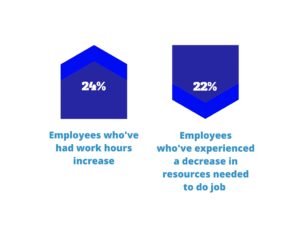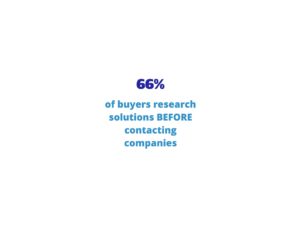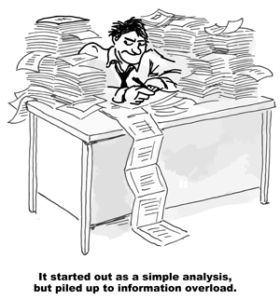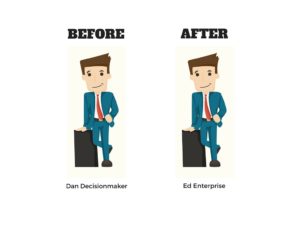I was having a conversation at lunch with a friend that has been in the marketing game for decades. He told me of a mutual acquaintance that had spent weeks crafting a “personas” for his technology firm. They had conducted internal meetings with the sales team, looked into web visitor data to see what was converting and what was not converting.
Created a killer presentation.
The meeting went really well. He faced the usual tough questions from some skeptics, but approval was given.
This colleague then moved ahead to implement and execute plans using the agreed upon personas. He went to a meeting with the user experience group and product development teams to show them the persona and started to get immediate pushback and hard questions. They presented their own user research that was conducted on a demo site. They had gathered data on how people used the site, who they were and what made them convert into qualified leads.
Now there were arguments about which customer and potential customer is the real target. It was like that book Sybil – multiple personalities dueling to be heard.
What happened? Why were there two different versions of reality?
Who is right?
Who decides?
What do we do going forward?
Several issues lead my friend and his effort off the rails – starting with the word personas.
How can you prevent this same marketing tragedy from derailing at least a few weeks worth of work?
Buyers are Humans Too
Using years of experience across different industries and many products, we have developed a process that is designed to create the most effective buyer groups that lead to increased revenue and profit.
Notice I did not use the word personas?
There is a good reason for that. And it is one of the reasons our friend ran into trouble.
The term personas is overused.
It is quickly getting tired.
It was created in a classroom. It is a generic term. And it is ironic that it is used to provide emotional context to customer groups.
In fact when writing a good headline for this post, every time I used the word personas instead of buyers or buyer groups or buyer decision groups, it brought the emotional score of the headline down 10% or more!
Personas have deservedly earned a bad reputation – not because the concept or idea of identifying your target customer is bad, but because the idea of coming up with a fictional representation of a diverse customer group does not represent the customer.
The typical way that teams and leaders are told to create personas is to think of your customer as not just demographics like age, sex and household income, but to also add behavioral and psychographic attributes and a cute name that brings a fuller picture into being.
Some marketing automation tools even encourage marketers to use personas to allocate resources.
And give you a handy template in powerpoint to go ahead and just type right into! Easy!
Personas are very often used by marketing automation systems to manage a funnel that is deemed to be linear. What stage of the decision process are buyers in so that you can serve them the right information at the right time.
A recent survey showed that up to 85% of companies don’t even use their personas that they spent time and effort creating. Unfortunately, although 73% of companies use, or plan to use buyer personas, the majority (85%) of companies are not using them correctly (according to the ITSMA).
85%!
This is a clear indication that a different approach is needed.
Creating a picture you can use
While creating personas may seem like sound judgement, the reality is that very few organizations take the time and spend the money to complete all of the research required to create a robust picture of who their buyers really are.
Most marketing teams are time and resource pressed and take short cuts. In fact, 24 percent of employees over the past two years have had their work hours increase, and 22 percent have had a reduction in the level of resources needed to do their job. A familiar situation for many, outlined in a study from Florida State University management professor Wayne Hochwater.

They might talk to sales people about who they are meeting with – and that’s certainly work doing – but according to Gartner – 66% of buyers have already spent time researching a solution before they even get in touch with a prospective vendor, get with a salesperson, or go to a website.

While sales is important -you must talk to customers, you must see what they do before they get to your lead funnel. This is why demand generation is important, you must influence and reach them before they become a lead. Most never even make themselves known to you.
Customers and potential buyers aren’t sitting in YOUR conference room. You must get out and talk to them.
To do anything different results in faulty assumptions and is one key reason why personas have gotten such a bad reputation. The rest of the organization can see Marketing coming with their cute titles like
“Successful Sally” and “Decision Driven Dan”. Fictitious representations created with the help of expert writers that sound great – but miss the mark.
What moves a buyer to action
You should really be interested in buyer motivations. Why people buy what they buy. It’s the age old question that even when you can measure everything, still leaves us stumped. Personas were designed to provide development, creative and other teams in the company with an image of a customer that they could use to create ideas or products around. They served as a focus point to keep in mind when creating.
What this does in reality is divorce the creative process and user design process from real customers and users.
This leads to the thinking from others that “marketing comes up with this stuff”.
And, like our real life example above – dismissed even before the ink is dry on the presentation.
How to prevent that from happening?
How do we go about this process in the right way to create a robust, actionable view that can be used to fuel decisions that lead to revenue growth and profitability. And that everyone can have the comfort of knowing they aren’t just developed by a few select people in a conference room.
Broad usage means better traction
The first step is to always assemble a cross functional team. Sales, product development, finance and customer service are all impacted by the creation of buyer groups and need to have a voice in their creation. Ensuring their participation allows you to balance different perspectives and thoughts.
The next step is to brainstorm and think about all of the ways that buyer groups could be used in the organization.
Here are several ways that we have successfully used buyer groups in companies we have worked with:
Product development
User experience design
Sales team alignment
Sales material development
Content development
Advertising
Brand positioning
Audience segmentation
Resource allocation
Marketing automation
Conversion tracking
Customer service scripts
There are many ways that buyer groups can be used within your company – they are not used exclusively for marketing. Challenge your team to come up with as many different impacts as possible to ensure that all areas of the company keep the buyers first in mind.
All about the money
The key to creating the most relevant buyer groups possible is to look at revenue factors. Focusing on demographics, how busy a buyer is, what they like to do for a hobby or how they like to receive information about your company or product neglects the key reason you are creating an understanding of who the buyers are – sales impact.
Look at the sales volume and trends of your existing customers first. Segment your current buyers into groups by total volume, then analyze by different secondary factors such as margin, customer service calls, geography and number of products they own. You can assign a weighted number to each of the criteria based on their relative importance to tease out the best view of your current customers.
Use the familiar 80/20 rule when looking at the data and apply across the groups to ensure that you are developing an understanding of the most margin rich customers. By looking at sales volume first, your buyer groups are organized by the most important rule first.
This analysis defines what is the most important principle in creating buyer groups – how much they spend.
From a revenue and margin platform you can then determine what buyer groups to research further as it will help you define the most valuable and margin rich opportunities.
Good answers from great questions
The next stage is to conduct the research. Good buyer group definition consists of interviews with existing and potential customers. Yes this takes time, but to not use in person or phone interviews limits your ability to ask good questions, follow up and truly understand what makes your buyers actively pursue your products. Make sure you cover all revenue and margin segments as well as the geographies that matter most.
Depending on the size of your business, the number of interviews will vary, but aim for at least S% to 10% of customers in each group. So if you have 300 existing customers, broken into three distinct revenue groups, you would then have S to 10 completed interviews in each group, and a total of 1S to 20. This is a guideline as the larger the company, the percentage should accordingly drop. You would mimic the figures for
potential customers, then gaining a total picture of the representative groups.
DOWNLOAD BOX Ten Questions to ask buyers
Don’t rely on sales to say “I know my customers – I talk to them all day” remember the research from Gartner that said 66% of buyers don’t even have contact with the company prior to making a decision.

So they really don’t have an idea what a majority of potential buyers are looking for to help them make a decision. Supplement the open ended interviews with website analytics, social cues gathered from sources like Facebook, Twitter and linked In, from current and potential customers, online surveys, Nielsen, IRI, Experian or other third party research depending on your category.
Assembling all of the information will take a team some time if it is done right. A key element of all of this is to understand where different customers are in the purchase cycle and what information they like to use to assist in making a sound decision about your category and product. The buying cycle is complex.
They might not be able to articulate it accurately, but that is why it is so important to have open ended interviews. The approach allows for give and take and the potential to uncover key information that could never be uncovered in just an online survey or a focus group. One of the key reasons personas took hold is that it provided a personality driven picture of who “customers” are.
Again, this is a fictionalized representation and provided a nice shorthand that creative thinkers could wrap their minds around. To ensure adoption, we have seen success when you actually trust the people you work with and provide them with the means and ability to assist in conducting the interviews.
In the place of Sally Superhero or Dan Decisionmaker, try actually giving them a moniker related to their revenue impact on the company. Represent them on a grid based on revenue and margin impact. Might use labels related to revenue sizing like Ed Enterprise or their distinct need for service after the sale like Customer Service Christy.
GRAPHIC Before and After man labels

Labels stick, make them relevant to your business and how they impact the revenue and margin, Gives a clear idea operationally and functionally what they focus needs to be when crafting and aligning the organization with these buyer groups.
DOWNLOAD BOX Ten Questions to ask buyers
Save the fluffy and cute names for your pets, they might sound great, but they don;t lend themselves to memorable or meaningful insight based on all the work that you have completed.
If you need expert help, give us a call or shoot us a note. We’d love to help.
